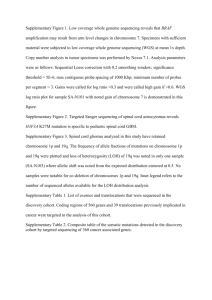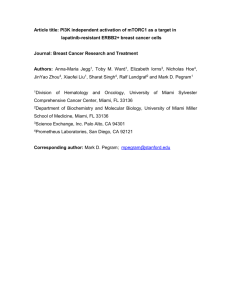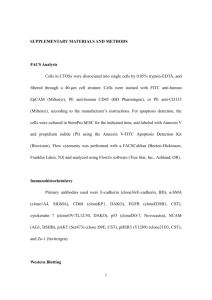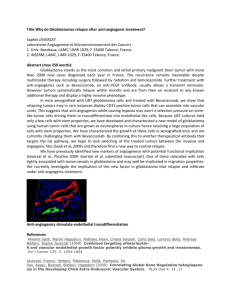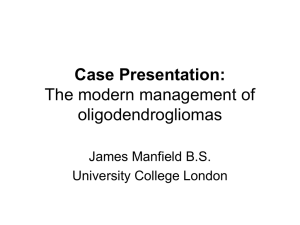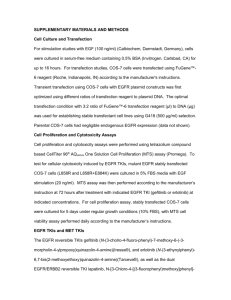Page 1 of 5 Test: SNP oligonucleotide microarray karyotype Patient
advertisement
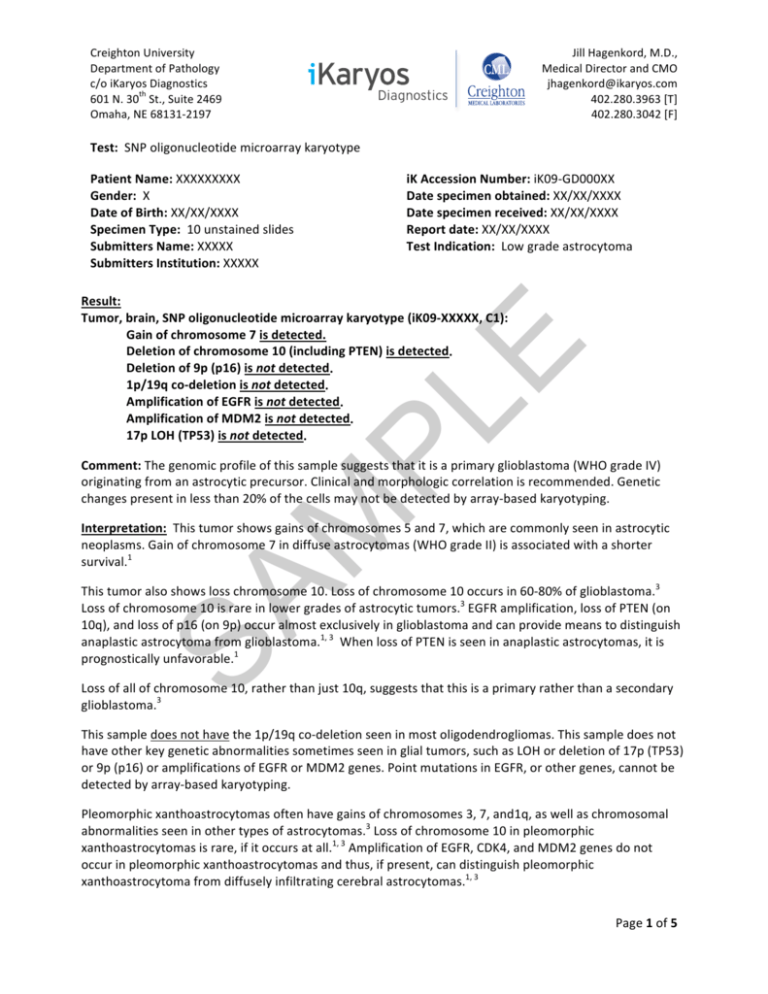
Creighton University Department of Pathology c/o iKaryos Diagnostics th 601 N. 30 St., Suite 2469 Omaha, NE 68131-­‐2197 Jill Hagenkord, M.D., Medical Director and CMO jhagenkord@ikaryos.com 402.280.3963 [T] 402.280.3042 [F] Test: SNP oligonucleotide microarray karyotype Patient Name: XXXXXXXXX Gender: X Date of Birth: XX/XX/XXXX Specimen Type: 10 unstained slides Submitters Name: XXXXX Submitters Institution: XXXXX iK Accession Number: iK09-­‐GD000XX Date specimen obtained: XX/XX/XXXX Date specimen received: XX/XX/XXXX Report date: XX/XX/XXXX Test Indication: Low grade astrocytoma PL E Result: Tumor, brain, SNP oligonucleotide microarray karyotype (iK09-­‐XXXXX, C1): Gain of chromosome 7 is detected. Deletion of chromosome 10 (including PTEN) is detected. Deletion of 9p (p16) is not detected. 1p/19q co-­‐deletion is not detected. Amplification of EGFR is not detected. Amplification of MDM2 is not detected. 17p LOH (TP53) is not detected. SA M Comment: The genomic profile of this sample suggests that it is a primary glioblastoma (WHO grade IV) originating from an astrocytic precursor. Clinical and morphologic correlation is recommended. Genetic changes present in less than 20% of the cells may not be detected by array-­‐based karyotyping. Interpretation: This tumor shows gains of chromosomes 5 and 7, which are commonly seen in astrocytic neoplasms. Gain of chromosome 7 in diffuse astrocytomas (WHO grade II) is associated with a shorter survival.1 This tumor also shows loss chromosome 10. Loss of chromosome 10 occurs in 60-­‐80% of glioblastoma.3 Loss of chromosome 10 is rare in lower grades of astrocytic tumors.3 EGFR amplification, loss of PTEN (on 10q), and loss of p16 (on 9p) occur almost exclusively in glioblastoma and can provide means to distinguish anaplastic astrocytoma from glioblastoma.1, 3 When loss of PTEN is seen in anaplastic astrocytomas, it is prognostically unfavorable.1 Loss of all of chromosome 10, rather than just 10q, suggests that this is a primary rather than a secondary glioblastoma.3 This sample does not have the 1p/19q co-­‐deletion seen in most oligodendrogliomas. This sample does not have other key genetic abnormalities sometimes seen in glial tumors, such as LOH or deletion of 17p (TP53) or 9p (p16) or amplifications of EGFR or MDM2 genes. Point mutations in EGFR, or other genes, cannot be detected by array-­‐based karyotyping. Pleomorphic xanthoastrocytomas often have gains of chromosomes 3, 7, and1q, as well as chromosomal abnormalities seen in other types of astrocytomas.3 Loss of chromosome 10 in pleomorphic xanthoastrocytomas is rare, if it occurs at all.1, 3 Amplification of EGFR, CDK4, and MDM2 genes do not occur in pleomorphic xanthoastrocytomas and thus, if present, can distinguish pleomorphic xanthoastrocytoma from diffusely infiltrating cerebral astrocytomas.1, 3 Page 1 of 5 Creighton University Department of Pathology c/o iKaryos Diagnostics th 601 N. 30 St., Suite 2469 Omaha, NE 68131-­‐2197 Jill Hagenkord, M.D., Medical Director and CMO jhagenkord@ikaryos.com 402.280.3963 [T] 402.280.3042 [F] Additional chromosomal abnormalities in this tumor include gain of chromosomes 19 and 20, gain of 22q11.1-­‐q12.2 and loss of 22q12.2-­‐q13.33 (see table below). Copy number variants or other genetic variants of uncertain significance are not reported, but are archived at Creighton Medical Laboratories. PL E Virtual Karyogram as log2ratio plot of CML09-­‐GD000XX, whole genome view. Chromosomes are color-­‐coded and plotted in order with chr 1 on the left and X on the right. The log2ratio is shown as a smoothed average over 30 SNPs. Hidden Markov Model (HMM) for copy number is coded as indicated at left. SA M Genomic position break points for CML09-­‐GD000XX. H&E photomicrographs of CML09-­‐GD000XX at 10x (right) and 20x (left). Page 2 of 5 Creighton University Department of Pathology c/o iKaryos Diagnostics th 601 N. 30 St., Suite 2469 Omaha, NE 68131-­‐2197 Jill Hagenkord, M.D., Medical Director and CMO jhagenkord@ikaryos.com 402.280.3963 [T] 402.280.3042 [F] SA M PL E Virtual karyogram of CML09-­‐GD000XX. Summary of Genetic Lesions in Glial Tumors In astrocytoma grade I, a normal karyotype is observed most frequently.3 Among the cases with abnormal karyotypes, chromosomal gains are seen most frequently in chromosomes 5 and 7.3 Gain of chromosomes 7q and 8q are the most frequent numerical aberration observed in diffuse astrocytomas (WHO grade II).3 Deletions of LOH of 22q (17%) and 6 (14%) are also seen in diffuse astrocytomas.3 The TP53 tumor suppressor gene is located at 17p13.1. TP53 mutations and/or 17p LOH are common in grade II and III astrocytomas.1, 3 In addition to frequent loss of TP53 function, loss of 10q occurs in 35-­‐60% of anaplastic astrocytomas (WHO grade III). PTEN is a tumor suppressor gene located at 10q23.31. Loss of PTEN is prognostically unfavorable.1 LOH 22q in anaplastic astrocytomas occurs at a frequency similar to that of low-­‐grade astrocytomas (25%), while LOH 19q is significantly more frequent (46%) in anaplastic astrocytomas.3 LOH 6q occurs in approximately 33% of anaplastic astrocytomas. EGFR amplification is very uncommon in anaplastic astrocytoma (<10%), and may be associated with significantly shorter survival.3 Molecular abnormalities in glioblastoma (WHO grade IV) are numerous and include deletions/mutations of p16 (9p) and PTEN (10q), LOH of 17p (p53), mutations in p53, and amplification of EGFR and MDM2.1 Homozygous loss of p16 occurs in 31% of glioblastoma.1 Loss of chromosome 10 occurs in 60-­‐80% of glioblastoma.3 Amplification of EGFR, loss of PTEN, and loss of p16 occur almost exclusively in glioblastoma and can provide means to distinguish anaplastic astrocytoma from glioblastoma.1, 3 Page 3 of 5 Creighton University Department of Pathology c/o iKaryos Diagnostics th 601 N. 30 St., Suite 2469 Omaha, NE 68131-­‐2197 Jill Hagenkord, M.D., Medical Director and CMO jhagenkord@ikaryos.com 402.280.3963 [T] 402.280.3042 [F] Amplification of EGFR indicates that the tumor may be responsive to EGFR inhibitors.1, 3 EGFR is the most commonly amplified gene in glioblastoma.3 Studies correlating EGFR amplification with outcome in glioblastoma have been contradictory. In anaplastic astrocytoma (WHO grade III), EGFR amplification has been associated with shorter survival.3 TP53 mutations deregulate control of cell growth and are they are the genetic hallmark of secondary glioblastoma. An alternate mechanism of TP53 deregulation is amplification of the MDM2 gene. MDM2 amplification is observed in 10% of glioblastoma without p53 mutations.3 Point mutations in TP53, or other genes, cannot be assessed by virtual karyotyping. Mutations TP53 or LOH of 17p are associated with a astrocytoma phenotype while co-­‐deletions of 1p/19q are associated with an oligodendroglioma phenotype.4 EGFR amplification is rare in oligodendrogliomas.3 PL E Up to 90% of WHO grade II oligodendrogliomas have LOH 1p and 19q.5 Tumors with the 1p/19q co-­‐deletion tend to have classic morphology. Most oligodendrogliomas show losses of one entire copy of 1p and 19q while partial deletions are rare.3 Oligodendrogliomas without losses of 1p and 19q frequently have more astrocytic features.4 The rate of combined 1p/19q co-­‐deletion in grade III oligodendrogliomas is 50-­‐70%.4 The 1p /19q co-­‐deletion is predictive of radio-­‐chemosensitivity in grade III oligodendroglial tumors and mixed oligoastrocytomas.2 SA M Several genetic aberrations in oligodendroglioma are associated with decreased progression-­‐free survival and inversely associated with 1p/19q co-­‐deletions, including TP53 mutations or 17p LOH, loss of chromosome 10, EGFR amplifications, and homozygous deletion of the p16 tumor suppressor gene on 9p21.4 Several chromosomal aberrations other than 1p/19q deletion are found at more than random frequency in oligodendroglioma, most frequently gains on chromosome 7 and losses on chromosomes 4, 6, 11p, 14, and 22q.3 Methods: DNA was extracted from formalin fixed, paraffin embedded tumor following pathologist review of the slide. Whole genome comparative genomic hybridization was done using an Affymetrix 250K Nsp SNP array, which can detect uniparental disomy and copy number changes as small as 500kb in when performed on fresh DNA. The resolution of paraffin embedded samples will vary, depending on the quality of the DNA. The resolution of this sample is estimated to be 1 Mb. The assay was performed according to the manufacturer’s protocol. Analysis was performed using Affymetrix™ GTYPE 2.0.1 and CNAGv3.0 6 software programs. OneClickCGH was used to generate the karyogram and table of genomic position breakpoints (InfoQuant, LTD, London UK). The normal reference DNA used for analysis was chosen by the CNAG software from a library of data files obtained from normal specimens. References: 1. Tumors of the Central Nervous System. Vol 7. Washington DC: American Registry of Pathology; 2007. 2. Magnani I. Nervous System: Glioma: an overview 2008. Atlas Genet Cytogenet Oncol Haematol. [http://AtlasGeneticsOncology.org/Genes/GliomaOverviewID5763.html. 3. WHO Classification of Tumours of the Central Nervous System. 4th ed. Lyon: IARC; 2007. 4. Hartmann C, von Deimling A. Molecular pathology of oligodendroglial tumors. Recent Results Cancer Res. 2009;171:25-­‐49. 5. Hartmann C, Mueller W, von Deimling A. Pathology and molecular genetics of oligodendroglial tumors. Journal of Molecular Medicine. 2004;82(10):638-­‐655. Page 4 of 5 Creighton University Department of Pathology c/o iKaryos Diagnostics th 601 N. 30 St., Suite 2469 Omaha, NE 68131-­‐2197 6. Jill Hagenkord, M.D., Medical Director and CMO jhagenkord@ikaryos.com 402.280.3963 [T] 402.280.3042 [F] Yamamoto G, Nannya Y, Kato M, et al. Highly sensitive method for genomewide detection of allelic composition in nonpaired, primary tumor specimens by use of affymetrix single-­‐nucleotide-­‐ polymorphism genotyping microarrays. Am J Hum Genet. Jul 2007;81(1):114-­‐126. SA M PL E This SNP based oligonucleotide microarray was developed by Affymetrix, Inc (Santa Clara, CA, USA) and its performance determined by the Genomics Laboratory of Creighton Medical Laboratories for the sole purpose of identifying the gain or loss of DNA copy numbers and regions of loss of heterozygosity. This microarray will not detect balanced chromosomal aberrations, such as Robertsonian translocation, reciprocal translocations, inversion or balanced insertions, nor imbalances in regions that are not represented on the microarray, nor low-­‐level mosaicism or tumor burden. This method cannot detect epigenetic events, such as aberrant methylation, or point mutations. The method is based on relative copy number estimates; therefore polyploidy cannot be reliably detected without a cell-­‐based assay. Clinical implications of chromosomal aberrations may be unknown at the time of analysis. This test is used for clinical purposes. It has not been cleared or approved by the U.S.Food and Drug Administration. The FDA has determined that such clearance or approval is not necessary. Pursuant to the requirement of CLIA’88, this laboratory has established and verified the test’s accuracy and precision. Page 5 of 5
